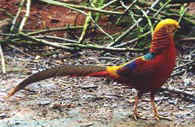Golden Pheasant
(Chrysolophus pictus)
Habitat: forests, bamboo woods and bushes in low and middle height mountain areas.
Feeding habits: peck with bills or scratch on ground surface then peck.
Food: young shoots, leaves, flowers, fruits of vegetation and insects.
Size: male golden pheasant has a body length of about 1 m; and female, 50 cm. Weight: 650 g.
 Habits:
resident bird and endemic specie of China. Male golden pheasant is one of the most beautiful fancy type pheasants. Baoji city of Shanxi province gets its name from the golden pheasants. As early as 200 years ago, Westerners introduced golden pheasants into Europe. The bird now has become the most commonly raised pheasant in all the zoos and wild zoos in the world. Normally, golden pheasants act in small groups and hang around in forests. During its mating season, male golden pheasants will occupy a piece of land and utter sounds like "ga, ga" to attract female pheasants. After mating, female golden pheasants will build a nest in secret places of the forests where they will produce eggs and hatch their young alone. Compared with male pheasants, female birds are completely brown, which is dotted with black spots. Besides, female pheasant has no feather crests and wraps. Such color is helpful for female birds to hide themselves when they are building nests or hatching eggs. Habits:
resident bird and endemic specie of China. Male golden pheasant is one of the most beautiful fancy type pheasants. Baoji city of Shanxi province gets its name from the golden pheasants. As early as 200 years ago, Westerners introduced golden pheasants into Europe. The bird now has become the most commonly raised pheasant in all the zoos and wild zoos in the world. Normally, golden pheasants act in small groups and hang around in forests. During its mating season, male golden pheasants will occupy a piece of land and utter sounds like "ga, ga" to attract female pheasants. After mating, female golden pheasants will build a nest in secret places of the forests where they will produce eggs and hatch their young alone. Compared with male pheasants, female birds are completely brown, which is dotted with black spots. Besides, female pheasant has no feather crests and wraps. Such color is helpful for female birds to hide themselves when they are building nests or hatching eggs.
Category: Ave, Galliformes, Phasianidae
Distribution: Northeast Yunnan, and their natural habitats are only limited to mountain areas in Middle and Mid-South China.
Level of protection: Class II key state protection animal of China
 
|